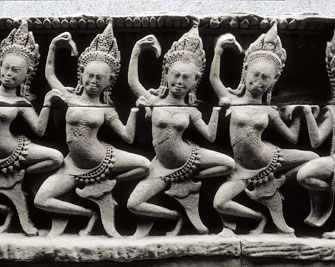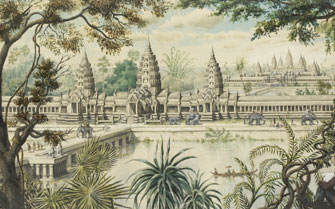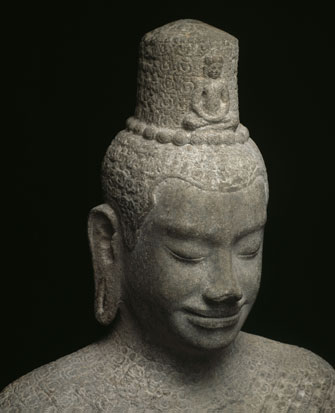The French ‘Discover’
Khmer Civilization

Cast of a bas-relief from Angkor Vat (early 10th century). © D.R.
The first section of the exhibition “Angkor: Birth of a Legend – Louis Delaporte and Cambodia” at Paris’s Asian museum, the Musée Guimet, is rather hard going. It is not so much about Angkor as about how the historic seat of Cambodia’s Khmer Empire became known to the European, and especially French, public through the eyes of French explorer Louis Delaporte (1842-1925), who fell in love with the region’s fantastical sculptural monuments when he first saw them in 1873 and devoted his life to documenting the sites and promoting knowledge of the Khmer civilization, which he considered the equal of those of ancient Egypt, Greece and Rome.
For the visitor to the exhibition, that means slogging through lots of text telling the story of this man and the growing awareness of Angkor in France and how it inspired pavilions at

Detail of a view of Angkor Vat by Louis Delaporte (c. 1868). © D. R.
international exhibitions and so on. It’s a long story, complete with many lovely drawings of the site by Delaporte and others, along with photos and other documents.
What the French thought of Angkor in the late 19th and early 20th century, however, is really not terribly interesting to the general public. Luckily, the exhibition becomes far more compelling when the actual objects brought back by Delaporte begin to appear, along with loans from other museums, including the National Museum of Cambodia and the Angkor National Museum.
Delaporte had casts made of many of the Angkor bas-reliefs and shipped them back to France. These are invaluable records of works that many people will never get to see, especially since the originals may have deteriorated or been destroyed or looted since the casts were made in the late 19th century.
The casts themselves were almost lost to history as well: they languished in the basement of a French abbey until 2012, when they were rescued, restored and integrated into the Musée Guimet’s collection. On display in the museum’s basement, they merit close examination, with their graceful, lively depictions of stories from the Ramayana and other legends. A special treat in this section is a display of Auguste Rodin’s wonderfully fluid and suggestive drawings of Cambodian dancers he saw performing in Paris.
The real joy, however, comes when you go upstairs to the main hall of the museum, where the show continues with its incredible collection of Khmer statues. Just being in the

Temple of Preah Thkol, Preah Khan of Kompong Svay (late 12th-early 13th century). © D.R. calming and uplifting presence of these buddhas and bodhisattvas with beatific smiles on their beautifully carved faces is better than taking a tranquilizer.
Those in the Bayon style (late 12th century-
early 13th century), such as a probable portrait of Jayavarman VII, are especially superb. A magnificent head of a male divinity in the Pre Rup style (10th century) is notable for its personality and the sensitivity of its modeling, while a Bayon-style elephant, the size of a baby elephant, also in the Bayon style, cannot help but charm.
Delaporte’s dearest wish was that the artifacts and casts he brought back from Cambodia would become part of the Louvre’s collection. That didn’t happen, but in his lifetime his treasures were shown in two museums – the Musée Khmer de Compiègne and the Musée Indochinois du Trocadéro, which he founded in 1882 (it closed in 1927). Since they now belong to the Musée Guimet, the Louvre of Asian art, one might say that Delaporte’s wish has finally been granted.
Musée National des Arts Asiatiques-Guimet: 6, place d’Iéna, 75116 Paris. Métro: Iéna. Tel.: 01 56 52 53 00. Wednesday-Monday, 10am-6pm (until 9pm on January 8, 15, 22). Admission: €9.50. Through Jan. 27. www. guimet.fr
Click here to read all of this week’s new articles on the Paris Update home page.
Reader reaction: Click here to respond to this article (your response may be published on this page and is subject to editing).
Please support Paris Update by ordering books from Paris Update’s Amazon store at no extra cost. Click on your preferred Amazon location: U.K., France, U.S.
More reviews of Paris art shows.
© 2014 Paris Update
Favorite